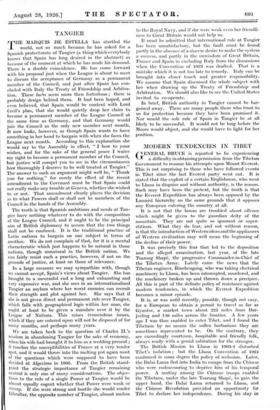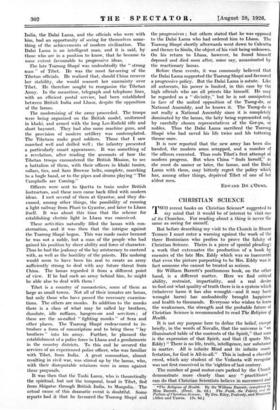MODERN TENDENCIES IN TIBET
GENERAL BRUCE is reported to be experiencing a difficulty in obtaining permission from the Tibetan Government to resume his attempts upon Mount Everest.
This is not surprising to those who have followed events in Tibet since the last Everest party went out. It is stated that the exploit of a certain Englishman, who went to Lhasa in disguise and without authority, is the reason. Such may have been the pretext, but the truth is that the Everest Expedition has always been opposed by the Lamaist hierarchy on the same grounds that it opposes any European entering the country at all.
It is not that the lamas are troubled about offence which might be given to the guardian deity of the mountain. They arc not quite so ignorant or super- stitious. What they do fear, and not without reason, is that the introduction of Western ideas and the appliances of Western civilization may well mean the beginning of the decline of their power.
It was precisely this fear that led to the deposition and the alleged assassination, last year, of the late Tsarong Shape, the progressive Commander-in-Chief of the Tibetan Army. Lately came the news that the Tibetan engineer, Rinchengang, who was taking electrical machinery to Lhasa, has been intercepted, murdered, and the machinery broken up and thrown down a precipice. All this is part of the definite policy of resistance against modern tendencies, in which the Everest Expedition becomes a minor episode.
It is, or was until recently, possible, though not easy, for a European to obtain a permit to travel as far as Gyantse, a market town about 225 miles from Dar- jeeling and 140 miles across the frontier. A few years ago I was thus enabled to enter Tibet, and I found the Tibetans by no means the sullen barbarians they are sometimes represented to be. On the contrary, they are exceedingly courteous, hospitable and friendly folk, always ready with a genial salutation for the stranger.
The British Mission to Lhasa in 1903-4 disturbed Tibet's isolation ; but the Lhasa Convention of 1904 confirmed in some degree the policy of seclusion. Later, the Dalai Lama fled into India to escape from the Chinese who were endeavouring to deprive him of his temporal power. A mutiny among the Chinese troops enabled the Tibetans, under the late Tsarong Shape, to gain the upper hand, the Dalai Lama returned to Lhasa, and the Chinese Revolution provided an opportunity for Tibet to declare her independence. During his stay in India, the Dalai Lama, and the officials who were with him, had an opportunity of seeing for themselves some- thing of the achievements of modern civilization. The Dalai Lama is an intelligent man, and it is said, by those who are in a position to know, that he became to come extent favourable to progressive ideas. '
The late Tsarong Shape was undoubtedly the " strong man " of Tibet. He was the most far-seeing of the Tibetan officials. He realized that, should China recover her stability, she would reassert her suzerainty over Tibet. He therefore sought to reorganize the Tibetan Army. In the meantime, telegraph and telephone lines, with an efficient postal service, had been established between British India and Lhasa, despite the opposition of the lamas.
The modernizing of the army proceeded. The troops were being organized on the British model, uniformed in khaki, and armed with the long Lee-Enfield rifle and short bayonet. They had also some machine guns, and the provision of modern artillery was contemplated. The Tibetans make good soldiers. Those that I saw marched well and drilled well ; the infantry presented a particularly smart appearance. It was something of a revelation, after reading the accounts of how the Tibetan troops encountered the British Mission, to see a battalion of them, with their officers in khaki tunics, collars, ties, and Sam Browne belts, complete, marching to a bugle band, or to the pipes and drums playing " The Campbells are Corning."
Officers were sent to Quetta to train under British instructors, and these men came back filled with modern ideas. I met several of them at Gyantse, and they dis- cussed, among other things, the possibility of running a light railway from Phari to Gyantse, and later to Lhasa itself. It was about this time that the scheme for establishing electric light in Lhasa was conceived.
These activities naturally filled the lamas with con- sternation, and it was then that the intrigue against the Tsarong Shape began. This was Made easier becausd he was not a noble, but a man of the people who had gained his position by sheer ability and force of -character. Thus he had the jealousy of the lay aristocracy to contend with, as well as the hostility of the priests. His undoing would seem to have been his zeal to create an army sufficiently strong to deal with any future threat from China. The lamas regarded it from a different point of view. If he had such an army behind him, he might be able also to deal with them !
Tibet is a country of monasteries, some of them as large as. small towns. Not all of their inmates are lamas, but only those who have passed the necessary examina- tions. The others are monks. In addition to the monks there is a class of what may . be called lay brothers, disiolute, idle ruffians, hangers-on and servitors ; of these are the so-called " fighting monks " of Sera and other places. The Tsarong Shape endeavoured to in- troduce a form of conscription and to bring these " lay brothers " into his army. Further, he planned the establishment of a police force-in Lhasa and a gendarmerie in the country districts. To this end he secured the services of an experienced police officer, who was familiar with Tibet, from India. • A great commotion, almost resulting in civil war, was stirred up by the lamas, who, with their disreputable retainers were in arms against these proposals.
It was then that the Tashi Lama, who is theoretically the spiritual, but not the temporal, head in Tibet, fled from. Shigatse through British India, to Mongolia.. The actual cause , of this dramatic event is doubtful. Some reports bad _it that he favoured the Tsarong Shape and the progressives ;, but others stated that he was opposed to the Dalai Lama who had ordered him to Lhasa. The Tsarong Shape shortly afterwards went down to Calcutta and thence to Simla, the object of his visit being unknown. On his return to Lhasa, however, he found himself deposed and died soon after, some say, assassinated by the reactionary lamas.
Before these events, it was commonly believed that the Dalai Lama supported the Tsarong Shape and favoured a progressive policy. But the Dalai Lama is astute. Like all autocrats, his power is limited, in this case by the high officials who are all priests like himself. He may be regarded as a " divinity," but he is not omnipotent in face of the united opposition of the Tsong-do, or National Assembly, and he knows it. The Tsong-do is not really a National Assembly since it is completely; dominated by the lamas, the laity being represented only by carefully chosen representatives of the Ger-pa, or nobles. Thus the Dalai Lama sacrificed the Tsarong Shape who had saved his life twice and his tottering throne once.
It is now reported that the new army has been dis‘ banded, the modern arms scrapped, and a_ number of the officers executed. Thus ends Tibet's first attempt at modern progress. But when China " finds herself," As she must do sooner or later, the lamas, and the Dalai Lama with them, may bitterly regret the policy which has, aniong other things, deprived Tibet of one of her ablest men.
EDWARD Da L'OR1tE.







































 Previous page
Previous page